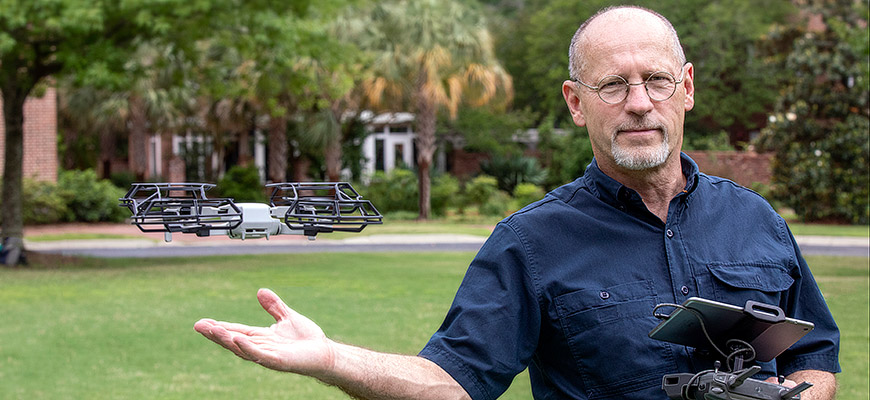
High-flying photography
New visual communications course puts students in the pilot’s seat
Posted on: June 9, 2021; Updated on: June 9, 2021
By Chris Horn, chorn@sc.edu, 803-777-3687
When Van Kornegay earned his pilot’s license last year, his feet never left the ground, but he paved a runway for students in the School of Journalism and Mass Communications.
Kornegay’s FAA drone license opens the door for him to teach a new visual communications course in which students will learn to fly camera-equipped drones that have become a go-to tool in documentary making, news gathering, infrastructure inspection, real estate marketing and more.
“If it’s visual, we do it,” says Kornegay, an associate professor in visual communications who helped pioneer the program several years ago in the College of Information and Communications. “I’m not really interested in flying — I’m interested in the camera, and the kinds of drones we use are basically cameras with wings.”
In planning the new drone-based visual communications course, Kornegay worked with George Patterson, a former CIC student who had left his studies in 1971, two credits shy of graduation. Patterson went on to a successful career as a producer for NPR and other major networks, but at age 68 he decided to complete his degree. Having used drones extensively during his career, he helped design the new visual communications course with Kornegay to earn his remaining credits.
They’ll log a lot of flight time. Once they get used to that, I’ll let them fly the bigger, more sophisticated drones to gather visuals they need for projects.
Van Kornegay
“We’ve developed a syllabus with a week-by-week itinerary that will take students through learning to fly the drones and capturing images,” Kornegay says.
In the past, Kornegay showed students how to fly drones under his supervision, but FAA regulations prevented the students from using the larger drones on their own to gather video and still images for class projects. Now he’ll be able to train the students how to fly the drones and use them independently once they’ve mastered the basics. For training, the college has several small drones, which are equipped with cameras and weigh under nine ounces.
“They’ll learn how to fly out and back, then box patterns and figure eights, takeoffs and landings,” he says. “They’ll log a lot of flight time. Once they get used to that, I’ll let them fly the bigger, more sophisticated drones to gather visuals they need for projects.”
Kornegay says the course will give students a head start if they want to pursue their own FAA drone licenses, which allow license holders to do commercial work with drones. “It’s a big plus if you can say to a potential client that you’ve got a drone license and insurance. If something happens during a drone photo shoot or the FAA comes after you and you don’t have a license, that’s a problem.”
Share this Story! Let friends in your social network know what you are reading about